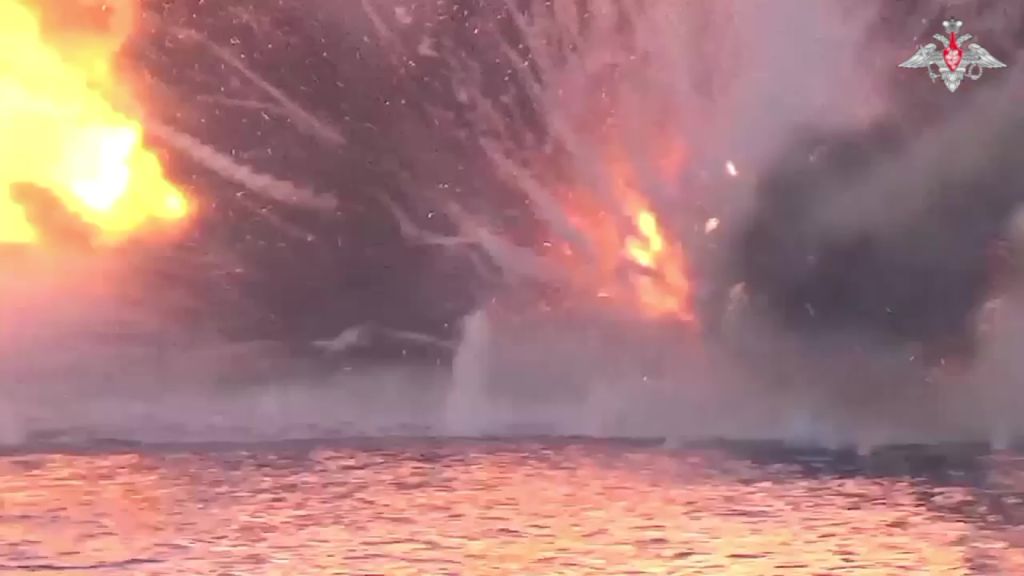
Many believe attacks on Russian warships by Ukrainian forces using uncrewed surface vessels (USVs) represent a fundamental shift in warfare at sea. Hugh White has argued that ‘surface ships these days are just inherently very vulnerable’ and that the drone attacks prove plans for the Royal Australian Navy are on the wrong track.
Retired US Navy admiral James Stavridis remarked that the attacks are a seminal moment in military history, like Agincourt or Pearl Harbor. ‘As cheap drones go to sea in serious numbers, expensive manned surface warships will be threatened.’
Claims about the novelty and impact of these small attack drones miss the wider picture. Asymmetric threats to major surface combatants are not new. The arms race between such threats and the ability of major warships to counter them is a recurrent theme of modern naval history.
In 1914 Admiral Percy Scott infamously argued that submarines had rendered major surface combatants redundant. Following World War II, airpower enthusiasts were so confident in their technology that some claimed that ‘by the inexorable logic of military progress, the navy as a separate entity will cease to exist’. Similar concerns over the vulnerability of surface combatants shaped debates in the 1970s, and have recurred with China’s development of A2AD technologies.
Despite these threats, surface combatants have remained essential to modern naval power, and will continue to be as long as we need to make use of the sea. This does not mean new technology like these USVs is not significant. Instead, it focuses attention on how navies should adapt and respond.
It’s useful to look back at the case study of the earliest of the modern asymmetric threats to surface combatants, namely torpedo boats. Until the middle of the 19th century the only effective counter to a major enemy warship was a ship of your own of equal size and strength. This changed dramatically in the 1870s due to the invention of the Whitehead torpedo and its integration into new fast launches—the first torpedo boats. Suddenly, the largest battleship could be sunk by the most insignificant craft.
As today, the potential of this asymmetric technology was apparent to all, and it left major navies with two key questions. The first was how to counter this technology and protect major warships. The second was how to adapt a technology that seemed suited to coastal states seeking sea denial to further their strategic purposes. These are the same challenges currently facing blue water navies over small attack USV technology.
There were numerous different responses from major navies to the torpedo boat threat. The most significant and successful in the short term was the proliferation of smaller calibre quick firing artillery which could engage the fast-moving torpedo boats. It took time for this to roll out across major surface combatants, but within a decade this was seen as offering a good degree of protection for fleets operating in the littorals. The other natural approach to any new technological challenge is to attempt to adapt that technology to provide a symmetrical capability. This saw the development of fast small craft described as torpedo boat destroyers which rapidly became an essential component of any fleet, screening the heavy vessels against attack.
We are already seeing a similar process in response to threats from fast inshore attack craft (FIAC), including drones. This has been under development for over 20 years, dating back to attack on the USS Cole. The adaption of the close-in weapon system to target surface threats, and development of lightweight missiles such as the Marlet provide significant protection. There remain questions over the degree to which drones, especially ‘swarming’ drones, may be able to overwhelm such defences, but this approach is set to be the foundation of short-term responses.
We are also beginning to see ideas mirroring the second response to torpedo boats. The US Navy is one of a number that have tentatively suggested that USVs might be able to escort larger crewed vessels operating inshore, protecting against threats such as FIAC. While this process is frequently presented as a radically new development in crewed/uncrewed teaming, it follows a long history of adopting and adapting a threatening technology to provide a symmetrical capability.
Another major response to the development of torpedo boats was a focus on harbour defence. The threat posed by a torpedo boat, or later a submarine, getting among an anchored fleet was obvious, and navies devoted huge resources to protecting anchorages. Despite this, there were major issues at the beginning of both world wars.
The potential for USVs and UUVs to operate in a similar way is obvious, as exemplified by Ukraine’s attacks on Sevastopol. So far there has been limited public discussion of the security of Western naval bases against such attacks, but it’s likely that this issue will need to be addressed.

The question of how to exploit torpedo boat technology proved an even greater challenge for 19th century navies than how to counter it. Like the small USVs of today, torpedo boats lacked the range or seaworthiness to fit into the existing concept of operations for a blue water navy. One innovative approach was the development of an early mothership, HMS Hecla, designed to carry torpedo boats into theatre where they could then support the fleet in confined waters.
This approach may have proved highly effective for a short period, but as technology developed the focus shifted onto larger ocean-going torpedo boats. These continued to grow, largely due to range and seakeeping issues, until they merged with the torpedo boat destroyers designed to counter them. This birth of the modern destroyer is a classic example of how navies adopt and adapt disruptive or asymmetric technologies. However, in doing so they tend to grow in size, complexity and cost, undermining elements of their advantage.
There is an irony in the fact that the antecedents of today’s major surface combatants that are derided as being obsolete were the product of a previous round of asymmetric innovation that were themselves supposed to drive major surface combatants from the seas. It is too early to tell if we will see similar trends in the development of attack drone style USVs and UUVs, but it seems far more likely that these will evolve into the surface combatants of the future than rendering surface combatants obsolete.

